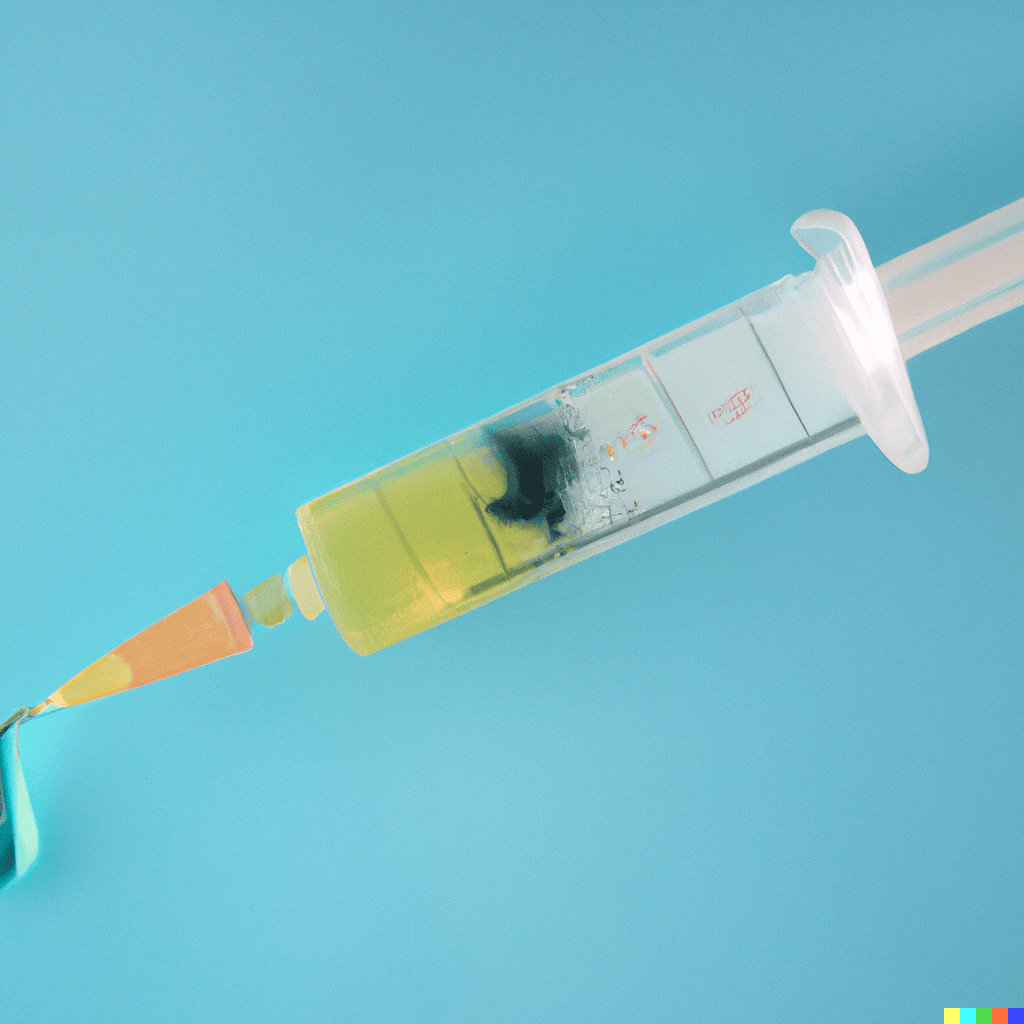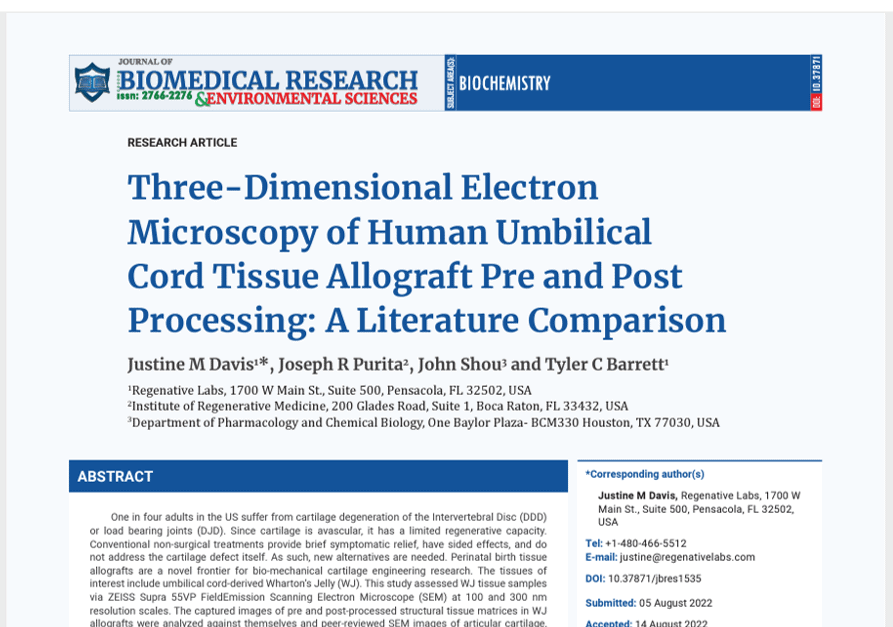Filling a Tissue Defect With Wharton’s Jelly Is Not Homologous Use: The Regenative Labs Warning Letter

I’ve blogged on Regenative Labs quite a bit. In part, that’s because this has been an interesting player in the regenerative medicine space. They first cooked up a plan to “fill tissue defects” and claimed that you could bill Medicare for their Wharton’s Jelly products when used to treat knee arthritis. When CMS pushed back, Regenative sued the entire Medicare program. Finally, they claimed that there were 180+ distinct homologous use applications for their umbilical cord products. So this week, in keeping with the “keeping it interesting” concept, they got an FDA Warning Letter. Let’s dig in on how the regulatory angle created by the company turned out.
Umbilical Cord Whartion’s Jelly
If you read this blog, you know that a number of companies and clinics had been selling umbilical cord Wharton’s Jelly and claiming that these products had millions of young, live, and functional stem cells. Regrettably, the actual peer-reviewed science never supported that any of this was true. Then some of these companies began telling physicians they could bill and get paid for using these products to treat knee arthritis and pain. This was also fiction and resulted in many clinics having to pay back many millions to the Medicare system. Over the past few years, there has also been a steady stream of Untitled and Warning Letters from the FDA to these companies stating that these products are not tissues that can be sold but unapproved drugs ((letter 1, letter 2, letter 3, letter 4, letter 5, and letter 6).
The Regenative Angle
Every one of these companies that were selling umbilical cord Wharton’s Jelly as a 361 registered tissue but who later got busted for selling an unapproved drug had an angle. I’ve covered many of these through the years. For example, a recent case was a company claiming to sell umbilical cord stem cells that claimed that you could use the FDA’s expanded access program to make this unapproved drug product legit. However, that company eventually got a nastygram from the FDA.
The angle for Regenative was also unique. On the billing side, the company focused on “filling a tissue defect.” This was very creative as Medicare approves countless products for this purpose. The only problem was that Medicare never authorized the use of umbilical cord tissue for this application.
On the regulatory side, Regenative had a square peg in a round hole problem.
Homologous Use
In order for an allogeneic tissue to be sold as a 361 product requiring only a minimal registration step, that product needs to be classified as “minimally manipulated.” The FDA created a multi-part test for that purpose. If you passed the test, you could sell that tissue with almost zero regulatory investment. If you failed the test, that product would require FDA clinical trials and drug approval, costing tens of millions of dollars. Obviously, every one of these companies selling umbilical cord tissue wanted to self-classify as “minimally manipulated.” That was possible because the classification was generally on the “honor system.” Meaning a company determined which pathway best fit its product.
A key hurdle to jump in fitting within that minimal manipulation designation is homologous use. This is one area where the Regenative product would fail the FDA’s minimal manipulation test. Meaning that umbilical cord tissue is not used in the body the same way that the company wanted to use it in patients. To get around this issue and to try to come up with a rationale on why its products were homologous, Regenative launched an entire program designed to make this square peg fit.
How could a substance that provided structural support for the umbilical cord be used in a homologous way in a knee? Some companies solved that issue by claiming they were using Wharton’s Jelly for “cushioning and support.” Hence injecting Wharton’s Jelly into a knee would provide cushioning and support for cartilage. However, this past year, FDA letters blew that concept out of the water, with the agency stating that the only homologous use for umbilical cord tissue was “serving as a conduit” for umbilical cord blood, which is specifically what an umbilical cord does in a baby.
Regenative took this concept of homologous use to high art. For example, check out this “study” they published in August of 2022:

In this paper, they used electron micrographs to show that the collagen patterns in Wharton’s Jelly, if you squinted, looked a little like those in knee cartilage. It was a scientific argument that didn’t hold much water, but it got an “A” for effort.
So how did that argument fair in Regenative’s Warning Letter? The FDA blew it out of the water:
“Your products are not intended to perform the same basic function or functions of the umbilical cord in the recipient as in the donor, such as serving as a conduit. Using your products to treat orthopedic diseases or conditions, for example, is not homologous use as defined in 21 CFR 1271.3(c).”
What’s In the New Warning Letter?
The FDA concludes that Wharton’s Jelly, when sold for use in treating orthopedic conditions, is an unapproved drug product. No new info here.
Here’s what the FDA found on an inspection of the Regenative labs facility:
- The aseptic processing protocols used by the company were never validated.
- No written procedures for environmental monitoring
- The CFU tolerances for bacterial testing in the lab were set too high
- Inadequate air and surface sterility testing in the lab
- Operators processing tissue without changing gloves after leaving the sterile clean room
- Operators potentially contaminating the sterile field
- No attempt was made to ensure the purity or strength of the product. Meaning that the company failed to ensure that unit A of their umbilical cord tissue was the same potency as unit B.
- No validation to ensure that frozen samples don’t lose their potency over time.
Basically, the FDA is holding Regenative to the cGMP drug factory processing standards, and the company failed that test in many different areas.
Reganative’s Response
The company tied to correct many of the issues above, but the FDA didn’t feel that many of the corrective actions solved the issue. Regenative also appears to continue to take the position that its products should be regulated at 361 tissues instead of 351 drugs. However, the FDA doesn’t appear to be drinking that Kool-aid. The FDA is giving Regenative 15 days to respond.
What’s Next?
While Regenative may be able to correct some of the processing deficiencies, it can’t address the Elephant in the room in 15 days or 15 months. The FDA is stating that the company is producing an unapproved drug product. Getting an IND to study these products in human clinical trials and then performing that research may take 5-10 years. That means the company can’t sell these products for clinical use without that prolonged approval process.
When Did These Inspections Occur?
This is the really interesting part. The company knew it was in deep trouble with the regulatory classification of its umbilical cord products as early as March 2022. That’s about the time that Regenative sued the entire Medicare program! It was just last summer that the company was instructing providers on how to write procedure notes to try to get Medicare to pay. Also, the paper on homologous use above appeared AFTER the inspection, so I would assume they knew they had a homologous use issue before the paper was conceived.
How Did My Prediction Fare?
In August of 2022, I made a prediction that companies like Regenative that sell umbilical cord products for orthopedic use would be out of business within a year. Here we are 11 months later, and IMHO, this FDA Warning Letter is the writing on the wall for Regenative. Meaning I would be very surprised if the company survives beyond the end of 2023.
It should also be noted that I have been contacted by a company insider who has relayed that there is yet another bigger shoe to drop here. However, I can’t independently verify anything this insider told me.
The upshot? As predicted, IMHO, Regenative’s days are numbered. While an FDA letter is certainly a big deal and, in this case, perhaps a company killer, are there other actions pending? After all, this is the company that was billing Medicare for these products, which Medicare determined weren’t covered. If the justice department believes that any of that product was billed knowing that there was no coverage, then there may well be another VERY BIG shoe to drop here.

If you have questions or comments about this blog post, please email us at [email protected]
NOTE: This blog post provides general information to help the reader better understand regenerative medicine, musculoskeletal health, and related subjects. All content provided in this blog, website, or any linked materials, including text, graphics, images, patient profiles, outcomes, and information, are not intended and should not be considered or used as a substitute for medical advice, diagnosis, or treatment. Please always consult with a professional and certified healthcare provider to discuss if a treatment is right for you.
